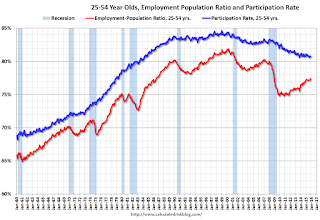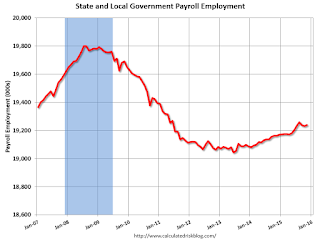by Calculated Risk on 12/04/2015 12:23:00 PM
Friday, December 04, 2015
Comments: Solid November Employment Report
This was a solid employment report with 211,000 jobs added, and employment gains for September and October were revised up.
Also wages increased, from the BLS: "In November, average hourly earnings for all employees on private nonfarm payrolls rose by 4 cents to $25.25, following a 9-cent gain in October. Over the year, average hourly earnings have risen by 2.3 percent."
Earlier: November Employment Report: 211,000 Jobs, 5.0% Unemployment Rate
A few more numbers: Total employment is now 4.5 million above the previous peak. Total employment is up 13.3 million from the employment recession low.
Private payroll employment increased 197,000 in November, and private employment is now 4.9 million above the previous peak. Private employment is up 13.7 million from the recession low.
In November, the year-over-year change was 2.64 million jobs.
Seasonal Retail Hiring

Typically retail companies start hiring for the holiday season in October, and really increase hiring in November. Here is a graph that shows the historical net retail jobs added for October, November and December by year.
This graph really shows the collapse in retail hiring in 2008. Since then seasonal hiring has increased back close to more normal levels. Note: I expect the long term trend will be down with more and more internet holiday shopping.
Retailers hired 604.5 thousand workers (NSA) net in October and November. Note: this is NSA (Not Seasonally Adjusted).
This is the same pace as last year, and suggests retailers are reasonably optimistic about sales.
Employment-Population Ratio, 25 to 54 years old

In the earlier period the participation rate for this group was trending up as women joined the labor force. Since the early '90s, the participation rate moved more sideways, with a downward drift starting around '00 - and with ups and downs related to the business cycle.
The 25 to 54 participation rate increased in October to 80.8%, and the 25 to 54 employment population ratio increased to 77.4%. The participation rate for this group might increase a little more (or at least stabilize for a couple of years) - although the participation rate has been trending down for this group since the late '90s.
Average Hourly Earnings

The graph shows the nominal year-over-year change in "Average Hourly Earnings" for all private employees. Nominal wage growth was at 2.3% YoY in November - and although the series is noisy - it does appear wage growth is trending up.
Note: CPI has been running under 2%, so there has been some real wage growth.
Part Time for Economic Reasons

The number of persons employed part time for economic reasons (sometimes referred to as involuntary part-time workers) increased by 319,000 to 6.1 million in November, following declines in September and October. These individuals, who would have preferred full-time employment, were working part time because their hours had been cut back or because they were unable to find a full-time job. Over the past 12 months, the number of persons employed part time for economic reasons is down by 765,000.The number of persons working part time for economic reasons increased in November to 6.09 million from 5.77 million from in October. This level suggests slack still in the labor market.
These workers are included in the alternate measure of labor underutilization (U-6) that increased to 9.9% in November.
Unemployed over 26 Weeks
 This graph shows the number of workers unemployed for 27 weeks or more.
This graph shows the number of workers unemployed for 27 weeks or more. According to the BLS, there are 2.05 million workers who have been unemployed for more than 26 weeks and still want a job. This was down from 2.14 million in October.
This is generally trending down, but is still high.
State and Local Government
 This graph shows total state and government payroll employment since January 2007. (Note: Scale doesn't start at zero to better show the change.)
This graph shows total state and government payroll employment since January 2007. (Note: Scale doesn't start at zero to better show the change.) In November 2015, state and local governments added 8 thousand jobs. State and local government employment is now up 197,000 from the bottom, but still 561,000 below the peak.
State and local employment is now increasing. And Federal government layoffs appear to have ended and, with the recent budget deal, Federal employment will probably increase in 2016. (Federal payrolls increased by 6,000 in November, and Federal employment is up 11,000 year-to-date).
Overall this was a solid employment report for November.


